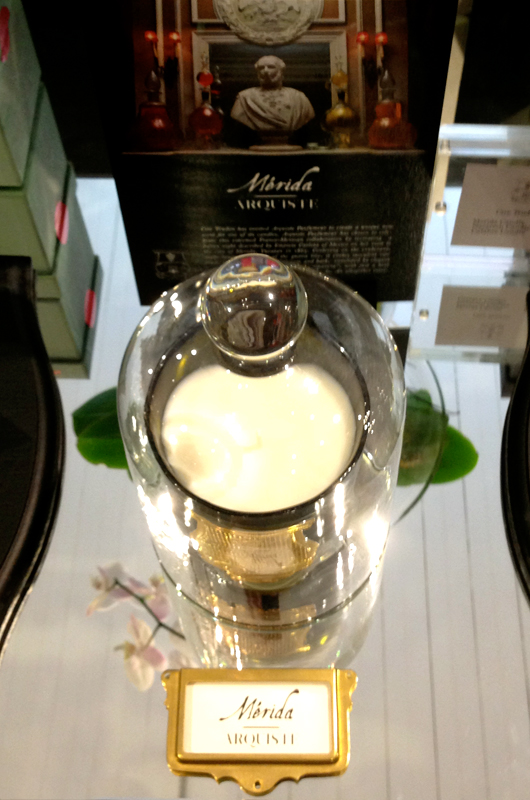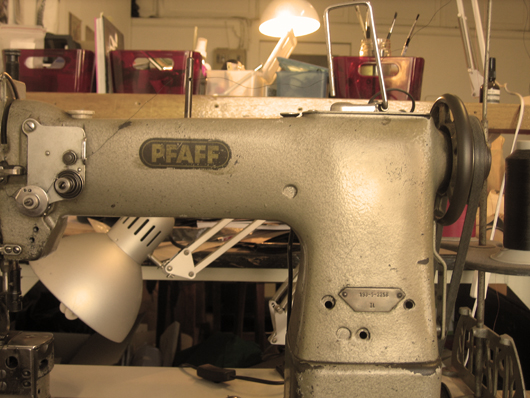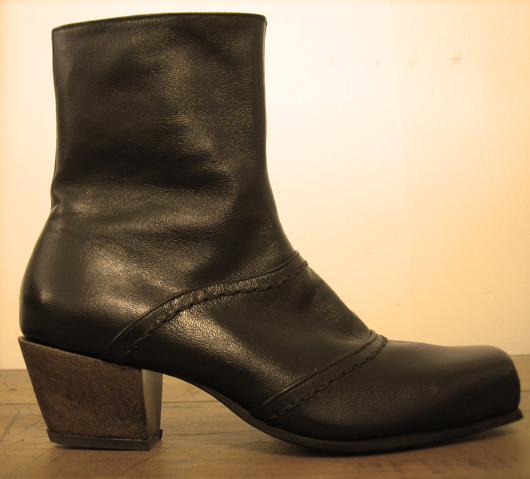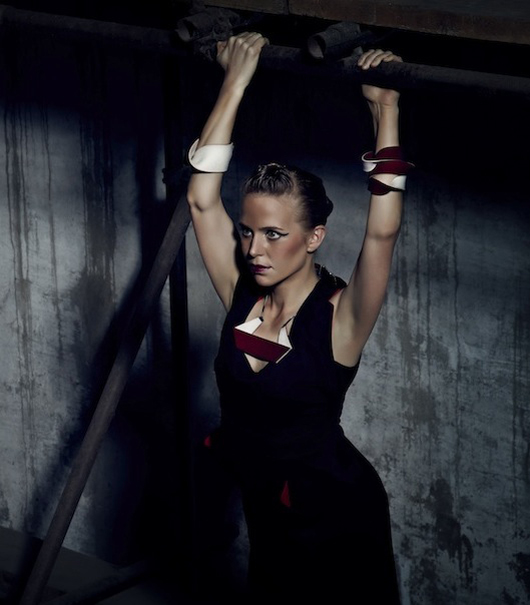Collaboration story: A fresh dining space on a tight budget
Our most recent Melbourne Members' Morning Tea was held in the brand new Free to Feed dining space in Northcote. It was a unique event for our event host and Board member Yvonne Meng, as her architecture firm, Circle Studio - that she runs with fellow CWC Member Amber Laing - was the creative force behind the design of the interior fitout!
Yvonne Meng and Amber Laing of Circle Studio Architects in their completed interior fitout for Melbourne social enterprise Free to Feed.
Our most recent Melbourne Members' Morning Tea was held in the brand new Free to Feed dining space in Northcote. It was a unique event for our event host and Board member Yvonne Meng, as her architecture firm, Circle Studio - that she runs with fellow CWC Member Amber Laing - was the creative force behind the design of the interior fitout!
We spoke to Yvonne about the project, the challenges of working on a tight budget for a social enterprise, and what they learned through the process.
What’s your architecture specialty and why were you drawn to work with Free to Feed?
We aren't bound to a particular typology but we try to take a collaborative approach to design. Amber and I like to work closely with people to make sure their project reflects them well. I was drawn to Free to Feed because Loretta and Dan have such a passion for their work, and it's really infectious. What attracted me most were the initiatives do with refugees and new migrants. Being the child of migrants myself, I remember seeing how difficult it was for my parents in the 80's to make sense of a new country and navigate work. I love that an organisation like Free to Feed exists to empower, provide entrepreneurial support and help people have agency in what they do within a community.
Before: What the space looked like when the lease was signed
Installation begins
What was the brief for the fitout and what mood/vibe were you aiming for?
The brief was to create a space which could be used in a variety of ways from sit down dinners, casual lunches, displaying and selling spices, presentations, workshops, cooking classes and more. It also had to be able to be packed away when needed, and there needed to be enough flexibility for the space to evolve as Free to Feed grows. For this, we designed modular trestle-style benches and fold-down tables which can be cleared out of the way or re-arranged as needed. Keeping the cooking classes in mind, we needed to bring power to the centre of the space. To do this neatly we adapted some light fittings to hold power points instead of globes so they were practical as well as decorative. When we sat down to discuss the mood and vibes we were hoping to achieve, we were drawn to this one particular image on our shared Pinterest board of a spice market with lovely earthy tones, pinks, and terracottas. This became the basis for the palette which ran through the interior and the aim was to create a workspace which was warm, bright and also a bit playful.
The mural goes up!
What strategies did you employ to get the most out of a social enterprise budget?
Free to Feed were lucky to have received some very generous donations from people who believed in their work. Anchor Ceramics provided 10 terracotta pendant fittings, and Spencer Harrison painted the mural on the wall. Without these, the space as it is would not have been possible. We needed bang for buck for this project and paint is such a great cost-effective way to transform a space, so to help differentiate zones we used blocks of colour on the walls which picked up on the colours in the mural and light fittings. The benches are cut from full off-the-shelf sheets of ply and dimensioned so that there was minimal cutting required and no offcuts. Unless it was absolutely necessary, we tried not to move any plumbing, gas, and electrical and we repaired the wall linings instead of ripping them off. Luckily for us, underneath the laminated floor of the original shop was a fabulous terrazzo flooring which was still in good nick.
Were there any special considerations/challenges?
Time was a challenge on this one. There was a very short period to get the design and drawings done, appoint builders and then get the thing actually built. The builders, Ampson Developments, programmed the works really well and kept things going at lightning speed to hit the completion date. From our side, we issued general drawings at the beginning - enough to get a quote on and get started - and then developed details simultaneously as construction occurred to save on time. Projects like these really make you appreciate the value of having a good collaborative team who are communicative and on the same page. The finished space did differ a little from the original concept as things had to fall away or change, but that's normal for any project! It reached completion just in the nick of time - the day after the builders moved out was the first dinner event.
What did you learn through the process?
You don't need need to make drastic structural changes to make a statement when working with existing buildings. Work with the bones that you've got - do little, but do it well. You can achieve a lot with a small budget that way!
The final space!
'Before' photos by Yvonne. 'After' photos by fellow CWC Member, Jade Cantwell.
Interview with Dawn Tan, illustrator and teacher
One of the greatest gifts that illustrator, teacher, and soapmaker Dawn Tan gives her students is the permission to make mistakes. Having taught art since she was seventeen, as well as working as an illustrator, Dawn embraces the art process as changeable. “If you make a mistake, just go for it,” she said. “Change it up a bit. See how you can do something new out of that mistake that you’ve made.”
Dawn’s “Making Space” Dawn welcomes me into her Yarraville home in Melbourne’s inner west. We can feel it is going to be a warm day, but for the moment we are both thankful for the coolness of her kitchen and dining room.
Dawn’s studio space has a gentle filtered light. The Victorian terrace she shares with her husband, Darren, is filled with art by friends and by artists she admires—such as good friend Madeline Stamer—as well as objects collected on the couple’s travels. A recent trip to the U.S. and India has prompted new designs featuring images and patterns inspired by the American desert and India’s magical colours and spices.
The long wooden table in her dining room is where Dawn creates her illustrations. On the day I visit, the table is neatly arranged with resources for a work in progress. The watercolour painting she shows me is of her client’s grandparent’s home, which Dawn carefully paints with fine detail as a precious memory for her client.
A Creative Life Along with working as a freelance illustrator and having her work published by such clients as Frankie and Hooray magazines, Dawn teaches workshops for adults in her home, and for children as a school art teacher.
In the last six months, Dawn has also discovered a love of making handmade soaps—enticing in both looks and aroma. The packaging for her soaps bears Dawn’s signature watercolour drawings, and the scents include apple cider, Joshua tree cactus, and chai milk tea. “I started making soaps not only because I wanted soap for myself, but because I was going through quite a rough patch when I was teaching and working in my previous school,” she explained. “I found that I needed a way to relax and not think about anything else, to do something different for a change.”
In high school, Dawn had great support from teachers who recognised her natural artistic ability and encouraged her to pursue an artistic career. Her friends and family have also encouraged her to keep going with her art, in part by ordering prints and custom house portraits, buying soaps, and sharing her posts on social media. “A lot of my colleagues were amazing, super troopers, cheering me on,” said Dawn.
The Little Art Yurt In June 2017, Dawn will fulfill her dream of opening her very own art school: The Little Art Yurt. “I’ve always known that I wanted to teach,” she said.
As Dawn awaits delivery of a large round tent, which will fill the entire outdoor space in her courtyard, she prepares for the school—planning, designing brochures, and adding students’ names to the ever-growing waitlist. She already has the most elegantly made aprons ready and waiting for the first class, hung on a plywood rack made by her father-in-law. The Hedley & Bennett aprons are examples of Dawn’s attention to detail: she is sensitive not only to the ways children engage with art, but also to how they feel physically while creating art. The aprons let children move freely without being hampered by stiff, bulky art smocks.
Dawn possesses a true joy of teaching, describing it as something that feeds her creativity. “I find that, especially working with children, they have this sort of crazy, fun energy about them. It makes you learn how to let go and just relax,” she said. “I see it as an exchange of knowledge. I see kids as teachers as well.”
Dawn comes from a family of teachers. “Being able to share what I love—which is art—helps me be inspired. I enjoy having conversations with people, sharing experiences, food, laughs. All these things help me create better as a maker.”
Being an Artist At the end of each day, Dawn makes a deliberate effort to pack all of her work away onto her shelves, a method she has recently adopted. “I used to leave everything out lying on the table,” she said. “I used to have a separate table in a little corner, but then we bought this bigger table and I realised that having this big kitchen table forces me to put everything away. It actually helps me think better and work better because every day is a new fresh start.”
Dawn’s watercolour illustrations are distinctive, with their use of fineliner and watercolour. Layers of watercolour in elegant tones capture doughnuts, cakes, food, plants, houses, and packaged goods. Dawn decided a while ago that drawing people was not for her, preferring to draw inanimate objects. Her style brings the subjects she paints to life, as if we are experiencing them through her eyes. “One word that’s kept coming up over the years is ‘raw’: how my work is so raw, almost like reading through someone’s journal. I like that,” she said.
Dawn is open and honest in the way she shares her life and work online. “When you have a very personal voice—when you’re just you and when you don’t hide, when you don’t make it all look nice and fancy—I find that people actually appreciate it more,” she said. “I always wanted to be the sort of artist where there’s no hiding, so, yeah, I think I’ve achieved that.”
Dawn’s Tip Dawn encourages women who want to start their own creative business, or who struggle to juggle their business with other demands, to believe in themselves. “Don’t doubt yourself,” she said. “I’ve learned over the years that if you’re going to sit there and hesitate and doubt yourself and think, ‘What if? What if?’ then it’s never going to happen. Just do it. If you fail, you fail. Dream big; go do it. If you don’t try, you’ll never know.”
To find out more about Dawn and her work, visit her website or follow her on Instagram (@handmadelove).
Photos and podcast audio production by Jenni Mazaraki
Jenni Mazaraki is an artist, designer, writer, and podcaster who helps women tell their stories. She is particularly interested in the ways women make time and space for creativity. You can see more of Jenni’s work at localstoryspace.com, on Instagram (@localstoryspace), or on Facebook.
Bricks and Mortar: Peony Haute Parfumerie
By Catherine Harvey Straight away, I feel the need to confess two things - Firstly, I must admit that I have never been an avid wearer of perfume and, secondly, that after I left Peony I really did want to keep this store my own little secret!
Jill Timms started Peony Haute Parfumerie nearly ten years ago and it is clearly evident that her passion for artisan perfumery has remained strong. Rather than stocking mass produced fragrance brands, her store contains (as she calls it) "a curated collection of historical and contemporary brands."
Jill is a self professed 'storyteller' and after spending only a short time in her store, it is the stories behind the fragrances and their creators that adds another dimension to the experience. There are so many brands in this store that are unique, such as: James Heeley - one of the few owner-founders of a luxury perfume house in Europe, Olfactive Studio - where perfumeurs have teamed up with photographers to draw inspiration from their works and also Naomi Goodsir - who had previously spent more than a decade being a milliner creating couture hats prior to turning her talents to perfume. Jill shares their stories and invites you into a sensory experience that is quite captivating.
Whilst in the store, I had a brief perfume consultation where Jill chose a selection of scents to ascertain which fragrances I preferred. After all, perfume is an emotional purchase and one that differs for each individual. There were quite a few scents that I actually liked but didn't feel quite reflected my personality - a realisation that made me aware I had never put much thought into the perfume I wore.
Jill discusses with me that it's about translating the purchase of a perfume into your everyday reality. And this is where the skill and expertise of Jill comes to the forefront. Whether it is based on your career, your upcoming wedding or purely your love for wearing perfume, Peony provides a personalised service that takes into account individual tastes and circumstances.
Jill has created a retail experience that feels as though she has allowed you into her own private sanctuary. An experience that you can't buy online and also an experience that would be difficult to replicate.
I left the store with more knowledge than I walked in with, a greater appreciation for the creators themselves and a newfound love for the scent I had purchased (Still Life by Olfactory Studio). I was a completely happy and satisfied customer - and how rare is that these days?
So now I have shared my 'secret' store with you and my new perfume has now become like my favourite pair of jeans - we are rarely apart. As to Peony Haute Parfumerie, I am now a customer for life.
Peony Haute Parfumerie, 107 Auburn Road Hawthorn 3122. Opening Hours: Monday to Friday 10-5pm, Saturday 10-4pm.
Catherine Harvey lives and breathes design. Working at one of Melbourne’s top studio’s, she is rarely ever away from her computer. She loves to keep up to date with the design industry in a global and local context and follows too many blogs to count! You can follow her findings here.
Tools of the Trade: Belinda Evans & Alchemy
By Brianna Read The interview for this first chapter in the second volume of Tools of the Trade raised two particularly pertinent topics for the wonderful platform for discussion that is the Creative Women’s Circle: social media and collaboration. I shall return to these topics shortly, but let me introduce the subject who brought these to the fore… Belinda Evans is the creator of Alchemy, a beautiful label and online store which I admired long before I crossed paths with Belinda herself.
My reason for this admiration was that this tiny little nook, in the vast ocean of online stores, managed to cultivate an extraordinary air of calm. As anyone who has lost their way while navigating the information superhighway will understand, calm is not something you happen upon very often. I mention this particular quality because Belinda’s extraordinary talent lies not only in her hands which craft each beautiful, thoughtful product you find in the Alchemy store, but also in her ability to create quiet space and genuine connection in the arena of online shopping and social media.
How, I wondered, has this woman stayed so true to the ethos of her slow, calm, creative practice while building a tiny empire and devoted following in the chaos of online?
Belinda spent her childhood surrounded by a wonderful array of tools: lathes and pottery wheels were both things she was encouraged to try and with a glass blowing studio and furniture making workshop at her fingertips it would seem a natural progression for such a childhood to lead on to a practice such as that displayed at Alchemy. But not without an invaluable step in a different direction…
Belinda also works in the field of project and event management and it is her experiences using social media in this environment which she credits with developing the skills that have proven invaluable in the development and management of the online presence of Alchemy. Take a quick look at the Alchemy blog or her Instagram posts and her genuine enjoyment of this media is wonderfully apparent. Her beautiful blog for Alchemy has a quiet sister in the blog titled Simple Things which Belinda dedicates to displaying images of a wide spectrum of design works which catch her eye and entertain her mind. Belinda says of her sharing ‘I’m not shy about sharing my techniques, how I source my materials, and the beautiful work of other artisans that I love to surround myself with.’.
This leads me to the second topic of collaboration. I recently read an article posted on Li Edelkoort’s Trend Tablet authored by Peter Stitger and to borrow his words ‘We are leaving an individual era behind us.’ This article continued on with a brief treatise on the merits of collaboration and fostering creative environments which work on the premise of camaraderie with the sharing of tools, knowledge and creativity at the center.
Belinda has exactly this approach to her practice, take one look at the beautiful photos of Belinda using indigo dyes for some of her new projects below. Taken by Olga Bennett, these photographs showcase the talents of photographer and subject in equal measure, a perfect example of the beauty of collaboration. This appreciation for the talents of others is one of the defining characteristics which make Belinda’s online voice so pleasant to listen to. In a time which seemed to favour the loudest and most shamelessly self-promoting voices, stumbling across Alchemy and then crossing paths with the quiet collaborator herself was equal parts breath of fresh air and renewal of faith in social media platforms. Belinda, thank you!
Belinda's blogs can be found here and here. Her lovely escape from the world store is here and to find her on Instagram she is known as: @iamalchemy...
Brianna Read is a designer and maker based in Melbourne. Her knitwear label Jack of Diamonds employs traditional hand-made techniques in combination with machine knit technologies. Her multi-faceted creative practice encompasses design, production, works for exhibition and machine knitting workshops.
Tools of the Trade: Sarah J Coombes Shoemaker
by Brianna Read
This month’s instalment of Tools found me in the charming rabbit warren of the Nicholas Building in the heart of Melbourne. This wonderful building is home to many talented folk of a creative bent but I had come to visit the studio of cordwainer (and CWC member) Sarah Coombes. The term cordwainer is a name given to artisans who craft shoes, different to a cobbler who traditionally repairs them…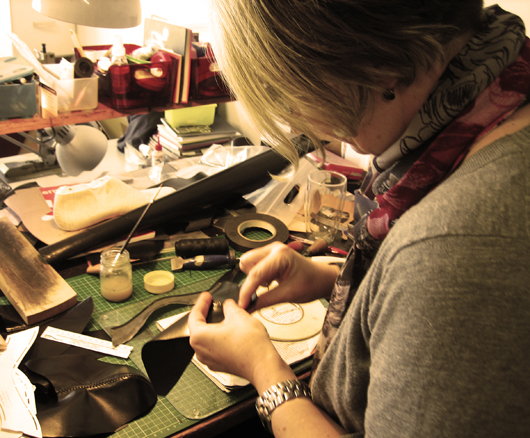
I didn’t know quite where to start with the tools of this trade, there are so many of them! Sarah’s beautiful, light filled workroom (which she shares with fellow hand crafter Phong Chi Lai) is packed with tools of every kind, there is serious machinery and workbenches covered with tools and materials. Sarah walked me through the studio introducing me to the bare essentials of her toolkit:
Hand skiving knife - starts as a flat length of metal about 25cm long without a blade edge, this has to be honed by hand, this makes each knife blade shape quite different as it is shaped by the technique of each maker.
Lasting pincers – these come in a range of shapes and are used repeatedly throughout the lasting process to stretch the leather around the last and hammer onto the insole.
Shoemakers hammer– a smooth rounded hammer on one side and curved edge the other, both sides are used for many different processes from neatening edges during lasting to hammering on the soles to the shoe.
And lastly the tool known to Sarah as Edith – a beautiful seventy year old Pfaff industrial post sewing machine, whose age has apparently not impaired her speed…They sure don’t build them like they used to!
Recently some of Sarah’s summer sandals made their way to Northcote shopping treat A Quirk of Fate and when I ask if they are available at any other retailer Sarah discusses the enjoyment she takes in the process of meeting with a client and crafting a pair of shoes just for them.
Given that many of her designs include time consuming details, such as hand stitching, I get the impression that this practice is very much about the crafting, this footwear is the ultimate in fast fashion antidotes. In addition to the high levels of hand craft involved in the making of each pair of shoes Sarah has also enlisted the talents of Melbourne jeweller Tessa Blazey to create metal embellishments for her designs, adding another tier of the bespoke to each pair leaving the studio.
Visiting the creative space of an artisan like Sarah whose trade has a long and rich history prompted a slew of questions about how she learnt to use such an extensive toolkit, a trade after all is usually something you must learn from another… Next month’s post will be the last for the year and Sarah has inspired the perfect wrap-up topic: masters & apprentices…
Brianna Read is a designer/maker based in Melbourne. Her knitwear label Jack of Diamonds employs traditional hand-made techniques in combination with machine knit technologies. Brianna’s multi-faceted creative practice encompasses design, production, works for exhibition and machine knitting workshops.
Tools of the Trade: Melanie Stapleton & Cecilia Fox
By Brianna Read
When I meet Melanie Stapleton she was hard at work putting the finishing touches on the brand new premises of Cecilia Fox. I know a little about florists, they work harder than most people imagine! The common perception of florist as a romantic career path filled with fragrance and beauty simply doesn’t cover it – there are early hours, really long days, hard physical labour and perishable produce. The reason I point this out is that Melanie sits opposite me in a café neighbouring her new shop, days from opening, nine months pregnant patiently waiting for my questions and not once do I sense an air of stress. This is one creative woman who has mastered the art of juggling – she looked serene!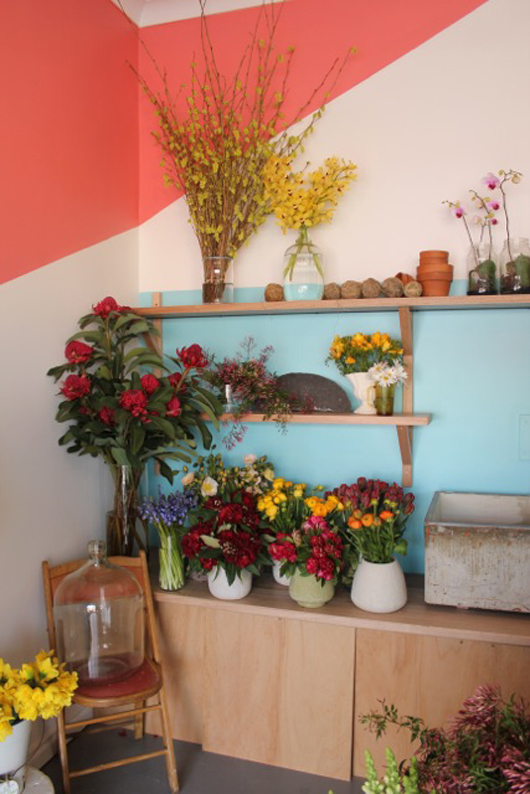
I admit I was quite familiar with Melanie’s work before we met – I have long admired her work, documented beautifully on her blog. I was very curious to hear about how she arrived at her particular design sensibilities, I always like to ask if the tools used by a creative have any particular history. When I point out that there have been no great advancements made in the tools used in floristry Melanie chuckles and replies ‘No, just a pair of scissors really!’.
Melanie has been running Cecilia Fox from a Brunswick workshop for over five years. Prior to going out on her own she spent years in Auckland, Sydney, London and finally Melbourne learning from others in the industry. She cites London as a turning point for her, here she discovered what floristry could be like. ‘I learnt that it was ok to specialise,’ She says ‘not in an exclusive sense, just that it was good practice to do what you do well rather than do many half-heartedly.’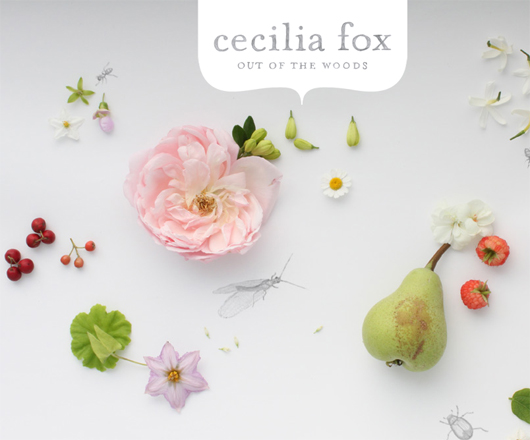
This particular quality is reflected so well in the lovely photographs of her designs. There is a distinct Cecilia Fox floral stamp and many other creative have recognised this. Since going out on her own Melanie has had a number of clients she lists as inspiring – all of which have recognised her keen design sensibility and asked her to bring a little into their worlds. Cecilia Fox was responsible for the floral designs in Husk for a number of years, she regularly works with the event coordinators Georgous and also works with Kuwaii for their eye catching window displays.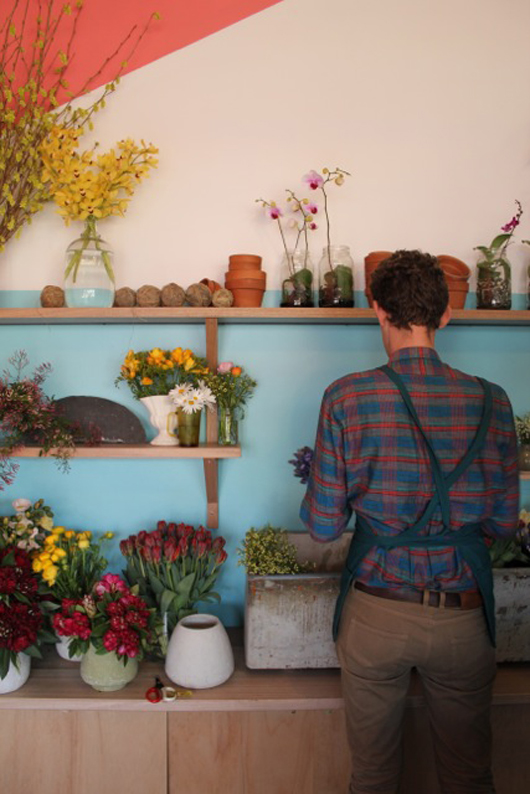
The new shopfront for Cecilia Fox can be found nestled between New Day Rising and Triple R headquarters on the thoroughfare from Brunswick to Northcote and is sure to attract many folk overjoyed with a lovely splash of colour and perfume in the neighbourhood.
 Melanie described the ethos of her approach as one driven by bringing beauty, understanding the client’s needs even when they are unsure. Most importantly, what I took from this inspiring interview was that when you remain true to your creative sense you will attract projects and clients which inspire and add fuel to the fire you laboured to build.
Melanie described the ethos of her approach as one driven by bringing beauty, understanding the client’s needs even when they are unsure. Most importantly, what I took from this inspiring interview was that when you remain true to your creative sense you will attract projects and clients which inspire and add fuel to the fire you laboured to build. 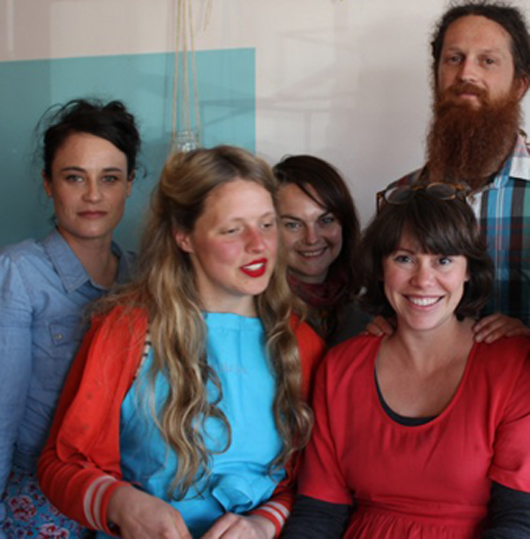
Cecilia Fox - Out of the Woods can be found at 221b Blyth St Brunswick. Melanie and her wonderful staff are instore from Thursday through Sunday with the following hours: Thu 9-6, Fri 7-7, Sat 8-4, Sun 10-2
Brianna Read is a designer/maker based in Melbourne. Her knitwear label Jack of Diamonds employs traditional hand-made techniques in combination with machine knit technologies. Brianna’s multi-faceted creative practice encompasses design, production, works for exhibition and machine knitting workshops.
Tools of the Trade : Taë Schmeisser
By Brianna Read In this second instalment of Tools I have the great pleasure to introduce you to the inimitable Taë Schmeisser. A Melbourne based designer and jeweller, Taë’s creative background is as diverse as her jewellery collections – Taë has studied glass and ceramics and more recently engineering technology (jewellery) – her design collections utilise materials from glass through to felt. Diverse though her materials and methods of construction may be, a consistent thread throughout each range of designs is that of the body and more specifically objects to be worn on the body.
So you can understand why I chose to interview Taë about the tools of her trade – which tool could a designer like this not live without? The answer: a sketchbook and pencil. Of course! Taë also mentioned that she would be rather lost without her flexi drive drill but continued on to explain that the sketchbook is the constant player in her tool kit, she says “It’s not particularly ordered and there is a whole lot of chicken scrawl, torn out pages of magazines, photos, embarrassing and impractical ideas but it’s where it all starts.”
As a designer ever ready to embrace a new material, Taë mentions the importance of the material informing the tools. She says that with the development process of every collection the ideas have to work their way around the materials chosen. For her most recent collection, titled Architexture (launched this month under the label Bëuy), a range of wearable works of art have been created using German wool felt and metal. The results are quite simply striking.
With a genuine love of exploring new territory this is reflected in her choice of favoured tool – it is the point where the working through of an idea begins. The sketchbook is the ‘this is where I want to go’ part of the design process. Taë calls it ‘tumbleweeding’, in reference to the action of an idea rolling around in the head of the designer.
On the horizon she is looking toward a collection which returns to one of her early loves – glass; but she is certainly not traversing old ground. Always up for a design challenge, her designs are incorporating elastic, glass and metal. I for one cannot wait to see the fruits of that adventure…
Architexture by is available online at www.beuy.com.au and in store at The Queensland Art Gallery of Modern Art Shop.
Brianna Read is a designer-maker based in Melbourne. Her knitwear label Jack of Diamonds Knits employs traditional hand-made techniques in combination with machine knit technologies. Brianna’s multi-faceted creative practice encompasses design, production, works for exhibition and machine knitting workshops.
















